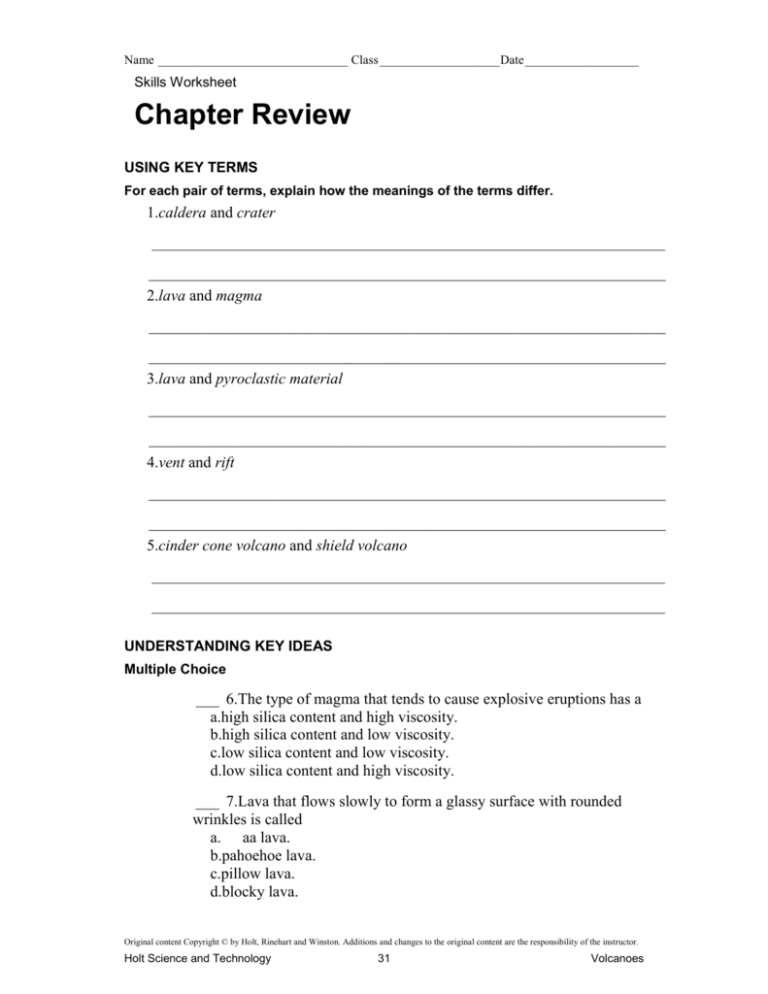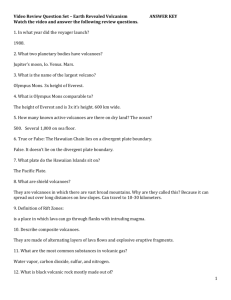mantle eruption
advertisement

Name ______________________________ Class ___________________ Date __________________ Skills Worksheet Chapter Review USING KEY TERMS For each pair of terms, explain how the meanings of the terms differ. 1.caldera and crater _______________________________________________________________________ __________________________________________________________________ 2.lava and magma __________________________________________________________________ __________________________________________________________________ 3.lava and pyroclastic material __________________________________________________________________ __________________________________________________________________ 4.vent and rift __________________________________________________________________ __________________________________________________________________ 5.cinder cone volcano and shield volcano _______________________________________________________________________ _______________________________________________________________________ UNDERSTANDING KEY IDEAS Multiple Choice ___ 6.The type of magma that tends to cause explosive eruptions has a a.high silica content and high viscosity. b.high silica content and low viscosity. c.low silica content and low viscosity. d.low silica content and high viscosity. ___ 7.Lava that flows slowly to form a glassy surface with rounded wrinkles is called a. aa lava. b.pahoehoe lava. c.pillow lava. d.blocky lava. Original content Copyright © by Holt, Rinehart and Winston. Additions and changes to the original content are the responsibility of the instructor. Holt Science and Technology 31 Volcanoes Name ______________________________ Class ___________________ Date __________________ Chapter Review continued ___ 8.Magma forms within the mantle most often as a result of a.high temperature and high pressure. b.high temperature and low pressure. c.low temperature and high pressure. d.low temperature and low pressure. ___ 9.What causes an increase in the number and intensity of small earthquakes before an eruption? a.the movement of magma b.the formation of pyroclastic material c.the hardening of magma d.the movement of tectonic plates __ 10.If volcanic dust and ash remain in the atmosphere for months or years, what do you predict will happen? a.Solar reflection will decrease, and temperatures will increase. b.Solar reflection will increase, and temperatures will increase. c.Solar reflection will decrease, and temperatures will decrease. d.Solar reflection will increase, and temperatures will decrease. __ 11.At divergent plate boundaries, a.heat from Earth’s core causes mantle plumes. b.oceanic plates sink, which causes magma to form. c.tectonic plates move apart. d.hot spots cause volcanoes. __ 12.A theory that helps explain the causes of both earthquakes and volcanoes is the theory of a.pyroclastics. c. climactic fluctuation. b.plate tectonics. d. mantle plumes. Short Answer 13. How does the presence of water in magma affect a volcanic eruption? _______________________________________________________________________ _______________________________________________________________________ _______________________________________________________________________ 14. Describe four clues that scientists use to predict eruptions. _______________________________________________________________________ _______________________________________________________________________ _______________________________________________________________________ _______________________________________________________________________ Original content Copyright © by Holt, Rinehart and Winston. Additions and changes to the original content are the responsibility of the instructor. Holt Science and Technology 32 Volcanoes Name ______________________________ Class ___________________ Date __________________ Chapter Review continued 15. Identify the characteristics of the three types of volcanoes. __________________________________________________________________ __________________________________________________________________ __________________________________________________________________ 16. Describe the positive effects of volcanic eruptions. __________________________________________________________________ __________________________________________________________________ CRITICAL THINKING 17. Concept Mapping Use the following terms to create a concept map: volcanic bombs, aa, pyroclastic material, pahoehoe, lapilli, lava, and volcano. Original content Copyright © by Holt, Rinehart and Winston. Additions and changes to the original content are the responsibility of the instructor. Holt Science and Technology 33 Volcanoes Name ______________________________ Class ___________________ Date __________________ Chapter Review continued 18. Identifying Relationships You are exploring a volcano that has been dormant for some time. You begin to keep notes on the types of volcanic debris that you see as you walk. Your first notes describe volcanic ash. Later, your notes describe lapilli. In what direction are you most likely traveling—toward the crater or away from the crater? Explain your answer. __________________________________________________________________ __________________________________________________________________ __________________________________________________________________ __________________________________________________________________ 19. Making Inferences Loihi is a submarine Hawaiian volcano that might grow to form a new island. The Hawaiian Islands are located on the Pacific plate, which is moving northwest. Considering how this island chain may have formed, where do you think the new volcanic island will be located? Explain your answer. __________________________________________________________________ __________________________________________________________________ __________________________________________________________________ __________________________________________________________________ 20. Evaluating Hypotheses What evidence could confirm the existence of mantle plumes? _______________________________________________________________________ _______________________________________________________________________ _______________________________________________________________________ _______________________________________________________________________ Original content Copyright © by Holt, Rinehart and Winston. Additions and changes to the original content are the responsibility of the instructor. Holt Science and Technology 34 Volcanoes Name ______________________________ Class ___________________ Date __________________ Chapter Review continued INTERPRETING GRAPHICS The graph below illustrates the average change in temperature above or below normal for a community over several years. Use the graph below to answer the questions that follow. 21. If the variation in temperature over the years was influenced by a major volcanic eruption, when did the eruption most likely take place? Explain. _______________________________________________________________________ _______________________________________________________________________ _______________________________________________________________________ _______________________________________________________________________ 22. If the temperature were measured only once each year (at the beginning of the year), how would your interpretation be different? _______________________________________________________________________ _______________________________________________________________________ _______________________________________________________________________ _______________________________________________________________________ Original content Copyright © by Holt, Rinehart and Winston. Additions and changes to the original content are the responsibility of the instructor. Holt Science and Technology 35 Volcanoes







